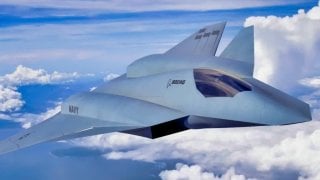The U.S. Navy's SSN(X) and F/A-XX Delays Could Be a Giant Mistake
The U.S. Navy is slowing the rollout of next-generation programs like the F/A-XX and SSN(X) because it wants to ensure that they meet the fleet’s current needs.
Summary: The U.S. Navy is adjusting its priorities in the face of fiscal constraints, opting to scale back some of its ambitious modernization programs. The Fiscal Year 2025 budget sees a 2.7% decrease in research and development funding and a significant 26.1% cut in military construction spending. This recalibration has led to a reduction in the number of new warships planned, from seven to six. Notably, the Navy has slightly increased its investment in the SSN(X) next-generation attack submarine's design and development, despite delaying its construction start from the mid-2030s to the early 2040s.
SSN(X): A U.S. Navy Submarine Mistake to Delay?
As reported this week, the U.S. Navy has deprioritized several planned modernization programs. The service will trim its research and development budget by 2.7% while cutting its military construction spending by 26.1%.
According to the sea service's Fiscal Year 2025 (FY25) budget request, the U.S. Navy will seek just six new warships instead of the previously planned seven.
The reductions will impact the future of the Navy's submarine fleet. The sea service requested $586.9 million for the design and development of its SSN(X) next-generation attack submarine, up slightly from the $544.7 million it requested in FY24.
But there is a challenge: the Navy also pushed back the start of planned construction on the sub. A U.S. Navy spokesperson told Defense News on March 14 that construction on the lead ship is now planned to start in the early 2040s. Last year, Navy officials said the new class was set to begin construction in 2035, already a delay from the previously planned starting date of 2031.
Concerning other projects, the DDG(X) program to develop a next-generation guided-missile destroyer for the U.S. Navy is still steaming ahead toward a planned FY32 start. There is no timeline for the F/A-XX – the manned fighter planned as part of the larger Next Generation Air Dominance family of systems – suggesting it is also delayed.
"If you look at F/A-XX, or the other X [next-generation] programs, we knowingly took risk in the schedule for development of those programs in order to prioritize those key investments whether that's readiness, or investing in our people, or undersea, to make sure that we make those programs whole," Navy Under Secretary Erik Raven told Defense News last week.
Uncharted Waters
The U.S. Navy is slowing the roll on the next-generation program because it wants to make sure to meet the fleet’s current needs. It is prioritizing present operations and personnel and exploring greater use of small unmanned systems, which could yield faster results for the fleet.
The near-term focus makes sense when considering that the 2020s are the decade of concern, with a Chinese invasion of Taiwan possible as soon as 2027. That would be long before the first F/A-XX or SSN(X) enters service.
"Our request prioritizes readiness and people in a constrained topline. The DON strategically allocates resources to our operations and readiness accounts to position the Nation's Naval Force forward in defense of our interests today," the Department of the Navy announced on March 11. "It enables our Naval and Marine forces to respond to contingencies, enhance interoperability with allied navies, and adapt to the emerging threats and opportunities in the maritime domain. Our request continues to show we are developing strong warfighting teams, recruiting/retaining talented people, and ensuring our quality of service meets the highest standards."
The near-term emphasis could create problems for the future, as the Navy will have to deal with aging nuclear-powered fast attack submarines.
Nevertheless, the current approach seems to be to focus on the next year, rather than the next decade. Only time will tell if it is the right decision.
Author Experience and Expertise: Peter Suciu
Peter Suciu is a Michigan-based writer. He has contributed to more than four dozen magazines, newspapers, and websites with over 3,200 published pieces over a twenty-year career in journalism. He regularly writes about military hardware, firearms history, cybersecurity, politics, and international affairs. Peter is also a Contributing Writer for Forbes and Clearance Jobs. You can follow him on Twitter: @PeterSuciu. You can email the author: [email protected].


